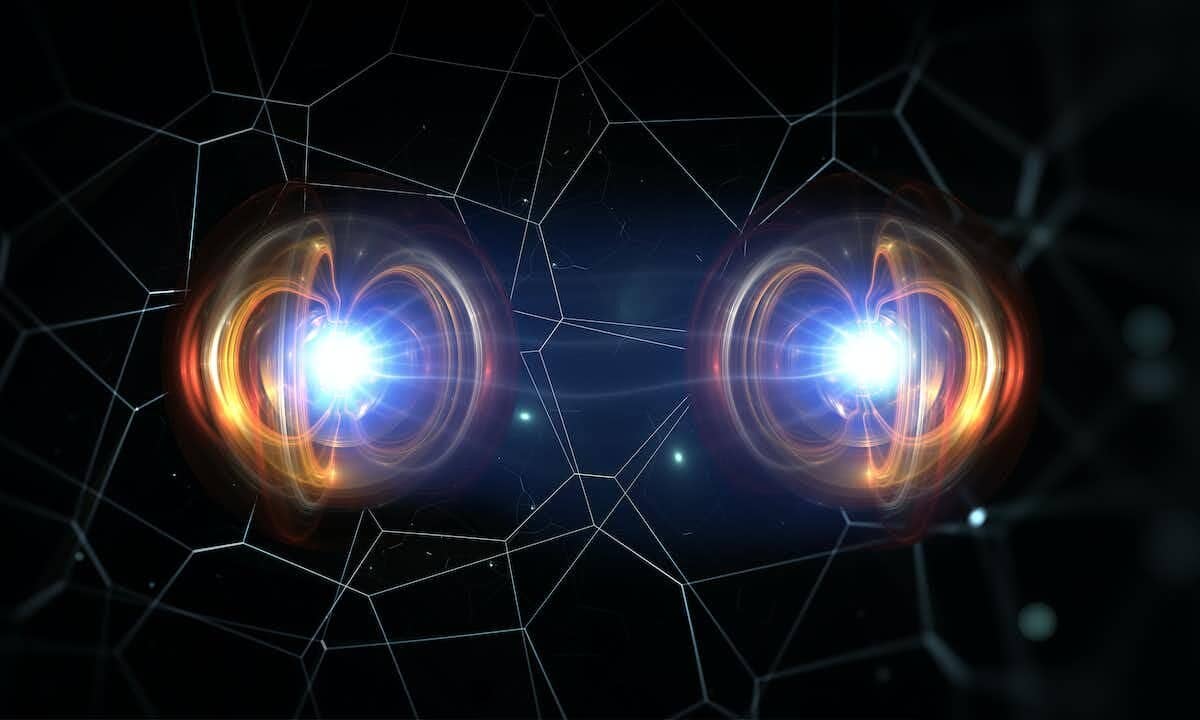Mysterious quantum paradox measured for the first time
Quantum physics has long been the subject of fascination with theories and predictions that challenge our understanding of the world.

[Apr. 29, 2023: Staff Writer, The Brighter Side of News]
Researchers has made a groundbreaking discovery about the connections between different particles or parts of an extensive quantum system. (CREDIT: Creative Commons)
Quantum physics has long been the subject of fascination and mystique, with theories and predictions that challenge our understanding of the world at its most fundamental level. Now, a team of international researchers has made a groundbreaking discovery about the connections between different particles or parts of an extensive quantum system, which they say have even stronger links than classical physics allows.
The team, led by Prof. Jörg Schmiedmayer, has confirmed for the first time that the mutual information in a many-body quantum system scales with the surface area rather than with the volume, according to their study published in Nature Physics. The theoretical input to the experiment and its interpretation came from the Max-Planck-Institut für Quantenoptik in Garching, FU Berlin, ETH Zürich, and New York University.
To understand this discovery, imagine a gas container in which small particles fly around and behave in a very classical way like small spheres, said Mohammadamin Tajik of the Vienna Center for Quantum Science and Technology (VCQ) - Atominstitut of TU Wien, the first author of the publication.
"If the system is in equilibrium, then particles in different areas of the container know nothing about each other. One can consider them completely independent of each other. Therefore, one can say that the mutual information these two particles share is zero."
Related Stories
But in the quantum world, particles behave differently. If particles behave quantumly, then it may happen that you can no longer consider them independently of each other. They are mathematically connected - you can't meaningfully describe one particle without saying something about the other. "In such a quantum gas, the shared mutual information is larger than zero, and it does not depend on the size of the subsystems - but only on the outer bounding surface of the subsystem," explained Tajik.
The experiment involved studying a cloud of ultracold atoms. The particles were cooled to just above absolute zero temperature and held in place by an atom chip. At extremely low temperatures, the quantum properties of the particles become increasingly important. The information spreads out more and more in the system, and the connection between the individual parts of the overall system becomes more and more significant. In this case, the system can be described with a quantum field theory.
"The experiment is very challenging," said Schmiedmayer. "We need complete information about our quantum system, as best as quantum physics allows. For this, we have developed a special tomography technique. We get the information we need by perturbing the atoms just a bit and then observing the resulting dynamics. It's like throwing a rock into a pond and then getting information about the state of the liquid and the pond from the consequent waves."
Vacuum chamber containing the atom chip. (CREDIT: Thomas Schweigler, TU Wien)
As long as the system's temperature does not reach absolute zero (which is impossible), this "shared information" has a limited range. In quantum physics, this is related to the "coherence length" - it indicates the distance to which particles quantumly behave similarly, and thereby know from each other.
"This also explains why shared information doesn't matter in a classical gas," said Tajik. "In a classical many-body system, coherence disappears; you can say the particles no longer know anything about their neighboring particles." The effect of temperature and coherence length on mutual information was also confirmed in the experiment.
Quantum information plays an essential role in many technical applications of quantum physics today. Thus, the experiment results are relevant to various research areas - from solid-state physics to the quantum physical study of gravity.
The experimental confirmation of the theoretical prediction is a significant step forward in our understanding of the quantum world. According to the researchers, this discovery could also have important implications for the development of future quantum technologies.
Schematic of the experimental protocol. (CREDIT: Nature Physics)
The findings of the experiment are significant for understanding the fundamental behavior of quantum systems. The fact that the mutual information shared between different subsystems of a many-body quantum system depends only on the outer bounding surface of the subsystem and not on its size is a surprising result that challenges our intuition.
Prof. Jörg Schmiedmayer, the leader of the international research team, says, "Our results demonstrate that the mutual information of a many-body quantum system is more strongly connected than classical physics allows. This finding has implications for a broad range of fields, including solid-state physics and the quantum physics of gravity."
Quantum information plays a vital role in many technical applications of quantum physics, such as quantum computing and cryptography. The experiment's results could provide insight into the behavior of quantum systems, which could be useful in developing new technologies.
Temperature dependence of MI and vN entropy. (CREDIT: Nature Physics)
"The results of this experiment are a significant step forward in our understanding of quantum systems," says Mohammadamin Tajik. "We have shown that quantum particles are not completely independent of each other but can share a certain amount of information. This could have important implications for future quantum technologies."
The research team hopes that their work will inspire further research into the behavior of quantum systems. "We are just scratching the surface of what we can learn about quantum systems," says Prof. Schmiedmayer. "There is still much to be discovered, and we hope that our work will inspire new insights and discoveries in this exciting field."
The team's findings were published in the scientific journal Nature Physics, one of the world's most prestigious scientific publications. The study is the result of a collaboration between the Vienna Center for Quantum Science and Technology, the Atominstitut of TU Wien, the Max-Planck-Institut für Quantenoptik in Garching, FU Berlin, ETH Zürich, and New York University.
The team's research has already received attention from the scientific community, with many experts praising the experiment's design and results. "This is an impressive experiment that provides a new perspective on the behavior of quantum systems," says Dr. Sarah Lloyd, a physicist at the University of Cambridge. "It is a significant step forward in our understanding of how quantum particles interact with each other, and it could have important implications for future quantum technologies."
The team's work also highlights the importance of collaboration in scientific research. "This experiment was the result of a collaboration between some of the world's leading quantum physicists," says Prof. Schmiedmayer. "It demonstrates the power of working together to achieve a common goal, and we hope that it will inspire more collaboration in the future."
For more science and technology news stories check out our New Innovations section at The Brighter Side of News.
Note: Materials provided above by The Brighter Side of News. Content may be edited for style and length.
Like these kind of feel good stories? Get the Brighter Side of News' newsletter.



